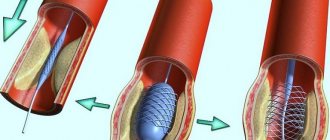What is a heart defect?
Heart disease is a pathological disorder in the structure and functioning of the heart that leads to heart failure.
The heart is a vital organ that performs the main function in the circulatory system, ensuring the movement of blood through the vessels thanks to its rhythmic contractions.
When pathological defects are observed in the condition of the heart, the first thing the body experiences is insufficient blood supply. If the degree of blood supply disturbance is high enough, then the person is given a disability. Heart defects are divided into:
- Congenital. Disturbances in the structure of the heart organ occur even before a person is born.
- Purchased. Heart pathology develops during a person’s life, for example, in the case of complications after an illness.
Heart defects are chronic diseases that gradually progress. Various therapeutic methods alleviate the condition of patients, but do not bring complete recovery. Therapy does not eliminate the cause of the disease. Achieving a complete recovery is only possible through surgery.
The consequence of the development of such a serious disease as heart disease is a gradual disruption of the functions of other human organs to varying degrees. To maintain health and avoid the development of more severe complications, correct knowledge about the dangers of heart disease is necessary.
Modern medicine has such a high level of development that even in the most difficult cases of organ disease, it can, if not cure it completely, then provide a person with a decent life.
Congenital heart defects
Congenital pathologies of the cardiovascular system are caused by various reasons. The main reasons include:
- heredity or genetic predisposition;
- existing deviations in genetic development, for example, Down syndrome;
- an infectious disease suffered by a woman during pregnancy;
- the effect of medications, as well as harmful chemicals in the initial stages of pregnancy, when the formation of the cardiovascular system occurs;
- excessive use of alcohol by a woman during pregnancy, as well as drug use.
Medical reference books describe more than a hundred heart diseases that are congenital.
The survival rate of children with congenital pathologies of heart development depends on how severe the disorders are. Unfortunately, even modern ultrasound examinations do not always help to identify the appearance of heart pathologies during pregnancy. This is the danger of birth defects.
Congenital heart defects are not always diagnosed at birth. Symptoms of the disease often appear throughout life.
The functioning of the heart is influenced by many different factors. Great responsibility in shaping the health of the unborn child lies with the mother who carries him. The more a woman worries about her health, the more likely she is to have a healthy baby, and the less likely the child will have birth defects.
Out of every thousand newborn babies, 6-8 children are born with heart defects. Congenital heart defects rank first among the causes of infant mortality in the first year of a child’s life.
How to apply for disability
How to apply for disability
- Obtain a referral to an ITU or a certificate of refusal to be referred to an ITU (from a medical organization, from a pension agency, or from a social security agency);
- Prepare identification documents: a passport of a citizen of the Russian Federation, a temporary identity card of a citizen of the Russian Federation, issued before issuing a passport, or their certified copies.
- Prepare a written application for an ITU.
- Contact the ITU office at your place of residence or place of stay with a package of documents: an identity document, an application for an ITU, a referral to an ITU or a certificate of refusal to refer, medical documents confirming a health impairment.
- Wait for an invitation to ITU.
- Go through a medical examination and get a decision.
- Obtain a certificate confirming the fact of disability.
What to do if referral to ITU is denied?
If you are denied a referral to the ITU, you must be issued a certificate of refusal to refer to the ITU, which gives you the right to submit documents to the ITU yourself without a referral (clause 19 of the Rules for recognizing a person as a disabled person, approved by Decree of the Government of the Russian Federation of February 20, 2006 No. 95)
.
What to do if the patient is unable to come for examination to the ITU facility?
If the recipient of a public service cannot come to the bureau and it is necessary to conduct an MSE at home, an appropriate conclusion from a medical organization providing medical and preventive care is additionally submitted (clause 90 of the Regulations for the provision of public services for conducting a medical and social examination)
.
How is disability determined?
When establishing disability, a quantitative assessment of the severity of persistent dysfunctions of the human body due to neoplasms is taken into account. It is based primarily on the assessment of local prognostic factors: localization and size of the tumor, anatomical form of growth, growth rate, degree of invasion of the organ wall (degree of invasion), histological structure and degree of differentiation, degree of malignancy, nature of damage to regional lymph nodes, presence or absence of distant metastases , stage of the tumor process (according to the TNMG system). The possibility of adaptation and compensation, and the presence of complications are also taken into account.
(Order of the Ministry of Labor of Russia dated December 17, 2015 N 1024n (as amended on July 5, 2016) “On classifications and criteria used in the implementation of medical and social examination of citizens by federal state institutions of medical and social examination" (Registered with the Ministry of Justice of Russia on January 20, 2016 N 40650 ) Registered with the Ministry of Justice of Russia on January 20, 2021 N 40650)
What is IPRA for a disabled person?
IPRA for a disabled person is a set of optimal rehabilitation measures for a disabled person, which includes certain types, forms, volumes, terms and procedures for the implementation of medical, professional and other rehabilitation measures aimed at restoration, compensation for impaired body functions, formation, restoration, compensation of the disabled person’s abilities to perform certain types of activities.
How to make changes to the IPRA of a disabled person?
If it is necessary to make additions or changes to the disabled person’s IPRA, a new referral for medical and social examination is issued and a new disabled person’s IPRA is drawn up.
Is an employee obliged, after his disability group has been determined, to inform the employer about this?
The employer is not legally required to provide documents confirming his disability. An employee can submit such documents at his own request, both when applying for a job and during his work activity.
Can an employee refuse the rehabilitation measures specified in the IPRA?
The employee has the right to refuse one or another type, form and volume of rehabilitation measures specified in the IPRA (IPR), as well as the implementation of the program as a whole. In this case, the employer is released from liability for its implementation. (Part 5 of Article 11 of Law No. 181-FZ, Part 7 of Article 11 of Law No. 181-FZ.)
What rights does a disabled person have at work?
- Duration of working hours of disabled people and payment for their work - no more than 35 hours per week with full pay (for disabled people of groups I and II);
- Involvement of disabled people in overtime work, work on weekends, holidays, and also at night is allowed only with their written consent and provided that this is not prohibited for them for health reasons in accordance with a medical report;
- The duration of annual paid leave for disabled people has been increased and must be at least 30 calendar days (Part 5, Article 23 of Law No. 181-FZ)
; - The employer is obliged to provide a disabled employee, upon his written application, leave without pay for up to 60 calendar days per year (paragraph 5, part 2, article 128 of the Labor Code of the Russian Federation, letter of Rostrud dated 04/16/2014 N PG/3387-6-1)
; - The employer is obliged to create and equip (equip) special workplaces for the employment of disabled people. (Part 1 of Article 22 of Law No. 181-FZ.)
; - Establishment of easy labor for disabled people.
If a disabled person, in accordance with the IPRA, can no longer work at his previous job?
An employee who needs to be transferred to another job in accordance with a medical report with his written consent, the employer is obliged to transfer to another available job that is not contraindicated for the employee for health reasons (Article 73 of the Labor Code of the Russian Federation)
, the employee retains the same average earnings for one month from the date of transfer.
Also, according to clause 9 of the Rules for recognizing a person as a disabled person, approved by Decree of the Government of the Russian Federation of February 20, 2006 No. 95
, disability of group I is established for two years, and disability of groups II and III - for one year. Thus, if a disabled employee who needs easier work has provided the employer with documents confirming the establishment of disability for a specified period, a temporary transfer is issued.
If an employee refuses to be transferred to another job in accordance with his medical report?
If, in accordance with a medical report, an employee needs a temporary transfer to another job for a period of more than four months or a permanent transfer, then if he refuses the transfer or the employer does not have a suitable job, the employment contract is terminated in accordance with clause 8 of Part 1 of Art. 77 Labor Code of the Russian Federation. In this case, the dismissed employee is paid severance pay in the amount of two weeks' average earnings (Part 3 of Article 178 of the Labor Code of the Russian Federation).
What is VMP and how much does it cost?
VMP – high-tech medical care.
VMP is provided in accordance with the List of types of VMF included in the basic compulsory medical insurance program and the List of types of VMF not included in the basic compulsory medical insurance program. Regardless of the type of medical care, it is free, since it is included in the Program of State Guarantees for the provision of free medical care to citizens and is financed by the Federal Compulsory Medical Insurance Fund.
How to get high-tech medical care?
Step 1. Contact your doctor.
Step 2. Wait for the VMP coupon to be issued.
Step 3. Wait for the decision of the commission of the medical organization providing medical care and hospitalization in the receiving medical organization.
Step 4. Upon completion of VMP, receive recommendations.
How to find out the status of a VMP coupon?
The status of the coupon can be viewed on the official website of the Russian Ministry of Health:
What to do if a doctor refuses to refer a patient for advanced medical care?
- Submitting an application or complaint to another authorized person of the referring medical organization;
- Filing an application or complaint to Roszdravnadzor or the government body of a constituent entity of the Russian Federation in the field of healthcare;
- Contacting a medical insurance organization or territorial compulsory medical insurance fund;
- Applying to the court to declare illegal the inaction of medical workers or refusal to refer for the provision of medical treatment.
What is the validity period of the quota and where can I get it?
The quota is issued by the health department at the place of residence in a specific medical institution and is valid from the moment of its issuance until December 31 of the current year.
Will the quota be valid for re-hospitalization?
If you are hospitalized again, you must take a new quota for treatment, even if hospitalization is planned for the current year.
What to do if there is a prescription, but the pharmacy does not have the medicine?
You need to fill out a prescription for deferred care at the pharmacy. There they are required to register it in the register of unsatisfied demand. Such a magazine should be in every pharmacy that dispenses drugs on preferential prescriptions. After registering a prescription, the pharmacy must submit a request for the drug to the pharmaceutical company authorized to supply preferential drugs to the region and provide the drug to the patient within 10-15 days. Deferred care is not a pharmacy's choice—it is the pharmacy's legal responsibility to arrange deferred care.
Prescriptions are issued with a validity of 30 days. Can a prescription be issued for a longer period of validity?
Prescriptions for medications written out on prescription forms Form N 148-1/u-04 (l) and Form N 148-1/u-06 (l), citizens who have reached retirement age, disabled people of the first group, disabled children, and also for citizens suffering from chronic diseases requiring long-term course of treatment, valid for 90 days from the date of issue.
For the treatment of chronic diseases, the specified categories of citizens can be issued prescriptions for medications for a course of treatment of up to 90 days. (Appendix No. 1 to the order of the Ministry of Health of Russia dated December 20, 2012 No. 1175n)
IMPORTANT MEDICATION INFORMATION!
1. Decree of the Government of the Russian Federation of July 30, 1994 N 890 (as amended on February 14, 2002) “On state support for the development of the medical industry and improving the supply of medicines and medical products to the population and healthcare institutions”
2. Order of the Ministry of Health of Russia dated December 20, 2012 N 1175n (as amended on April 21, 2016) “On approval of the procedure for prescribing and prescribing medications, as well as forms of prescription forms for medications, the procedure for processing these forms, their recording and storage”
3. Federal Law of July 17, 1999 N 178-FZ (as amended on December 19, 2016) “On State Social Assistance”
4. Federal Law of November 21, 2011 N 323-FZ (as amended on July 3, 2016) “On the fundamentals of protecting the health of citizens in the Russian Federation”
5. LIST OF VITAL AND IMPORTANT DRUGS FOR MEDICAL USE FOR 2021 (Approved by Decree of the Government of the Russian Federation of December 28, 2016 N 2885-r)
Disability due to congenital heart disease
There is a certain list of diseases for which disability is given. The most common diseases among congenital cardiac anomalies are:
- Mitral heart defects caused by abnormalities in the formation of the heart valve system. These include mitral stenosis and mitral valve insufficiency.
- Defects involving disruption of the normal functioning of the arterial valve - aortic stenosis.
- Tetralogy of Fallot is the most common defect among cyanotic defects. It is also considered very complex, as it has four anomalies at once.
Depending on the diagnosis of the disease, a decision is made to prescribe treatment. In the case of the birth of a child with Tetralogy of Fallot, only surgical intervention is necessary, which, however, does not provide a 100% guarantee of cure.
Children with heart disease, especially after surgery, require intensive care and need proper high-calorie nutrition. The child must be protected from infections. Parents need to know that proper care - maintaining a daily routine, strengthening the immune system, mandatory stay in the fresh air - is the key to the future health of the child.
A pressing issue for parents with children with cardiovascular diseases is the question of what heart defects cause disability in children.
When a heart defect is diagnosed, children are assigned disability, taking into account the consequences of the disease and the severity of the violation of the basic vital functions of the body.
The basis for recognizing a child as disabled with congenital heart disease are the following factors:
- significant disruption of the functioning of the body;
- limitation of life activity - disturbances in movement, communication, orientation, self-care;
- need for social protection.
Which disability group is given for congenital heart disease is a question that depends on the degree of impairment of the circulatory system and the degree of limitation of a person’s life activities.
To assign a disability group for congenital heart disease in adulthood, it is necessary to undergo a complete clinical examination. This is done in order to determine to what extent the existing pathologies of the organ interfere with the normal existence of the patient, and how negatively the disease affects the general health of the person.
Depending on the severity of the disease, the patient is assigned disability groups 1, 2 or 3. Group 1 is given to the heaviest patients, Group 3 - to patients with minor limitations in their ability to live.
Approaches to determining disability in children with congenital heart defects
Back to the program
Zubov L.A.
GBOU HPE Northern State Medical University;
Target.
In the structure of congenital developmental anomalies leading to disability in children of the Arkhangelsk region, in recent years the leading place (52–58%) has been occupied by congenital heart disease. Children with congenital heart disease make up about 20% of all children initially examined by the Bureau of Medical and Social Expertise (MSE).
A wide variety of congenital heart diseases with different hemodynamics sometimes causes difficulties in expert assessment of the degree and prognosis of functional disorders of the cardiovascular system in children. Every year, 150-170 children in the Arkhangelsk region are operated on in cardiac surgery centers for congenital heart disease. Timely diagnosis, modern advances in cardiac surgery and adequate rehabilitation have made it possible to ensure a decent quality of life for the majority of children with congenital heart disease, including those with complex combined defects. Assessing the degree of recovery and adaptation of hemodynamics after surgery and carrying out rehabilitation measures in such children requires an integrated approach. To a large extent, this relates to the correct interpretation of clinical and instrumental indicators in children.
Methods.
The criteria for determining disability in 583 children with congenital heart disease examined at the Main Bureau of Medical and Social Expertise in the Arkhangelsk Region were analyzed.
Results.
Thanks to the established practice of jointly resolving expert issues with pediatric cardiologists, unified practical approaches to establishing disability in children with congenital heart disease have been developed. Functional stress tests help to objectify the assessment. Medical criteria for medical and social examination for congenital heart disease with increased pulmonary blood flow are the degree of heart failure, the presence of pulmonary hypertension, the need to prescribe basic drug therapy (cardiac glycosides, diuretics, ACE inhibitors), the presence of complications (infective endocarditis, pulmonary, cardiac arrhythmias) and the effectiveness of surgical correction.
In case of blue-type CHD with reduced pulmonary blood flow, the severity of the course (frequency and severity of dyspnea-cyanotic attacks), the need for basic medications (beta-blockers), the presence of chronic hypoxemia (dysfunction of the central nervous system, dystrophy of internal organs) or complications (infective endocarditis, thromboembolism), radicality and effectiveness of surgical correction (long period of adaptation to new hemodynamic conditions in combined congenital heart disease).
In case of coarctation of the aorta, aortic stenosis, the indications for recognizing a child as disabled are the severity of NC, the degree of chronic insufficiency of cerebral and coronary circulation, complications (stroke, infective endocarditis, the formation of a prestenotic aortic aneurysm), the effectiveness and complications of surgical intervention.
Conclusions.
Clinical and functional criteria for establishing disability in congenital heart disease with different hemodynamics facilitates medical and social expert assessment of the degree and prognosis of functional disorders of the cardiovascular system in children.
Acquired heart defects
Acquired heart defects are diseases characterized by impaired heart function due to changes in one or more heart valves.
Emerging defects are the result of past diseases. The most common cause of pathological valve defects is rheumatism.
Other reasons that result in the development of acquired heart defects include:
- blood poisoning;
- chest injuries;
- atherosclerotic processes in a progressive form;
- organic heart disease of syphilitic origin.
Hidden heart defects are called compensated.
With decompensated defects, patients experience symptoms such as shortness of breath, increased fatigue, severe palpitations, and possible fainting. The number of heart diseases is increasing every year. We must not forget that the functioning of the cardiovascular system is negatively affected by various stresses, poor environment, poor lifestyle, bad habits, and poor nutrition. Timely measures can help avoid serious health consequences.
Treatment prescribed for acquired defects can be conservative or surgical. Conservative treatment includes the prevention of complications, relapses of the underlying disease that caused the acquired defect, and correction of heart function. If the ongoing therapeutic treatment does not bring the desired result, the patient is advised to consult a cardiac surgeon for timely surgical treatment.
Acquired heart defects are dangerous for the development of progressive heart failure, lead to disability, and can often be fatal.









